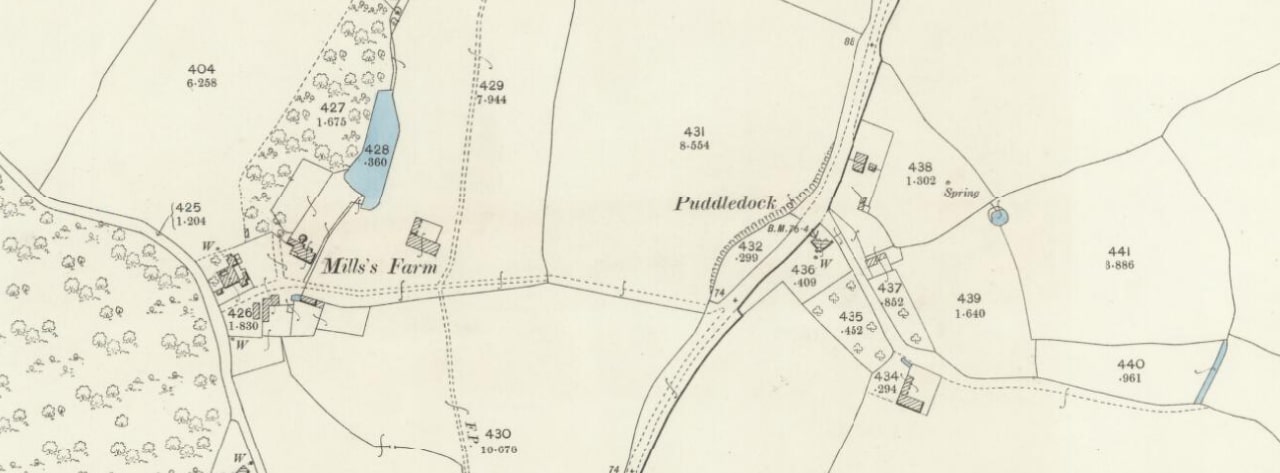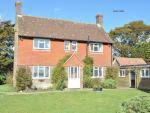Chapter 4 - Joseph Veness & Fanny Hook
Joseph Venes son of Joseph and Sarah was baptised on 5 October 1784 at Brightling Parish Church (Chapter 3). This is believed to be our Joseph who married in 1811. No age is given at the time of his marriage, but again this is the only entry in the Baptism's index in the County Records Office which covers all existing conformists Baptisms records at that time.

Joseph was the first of our ancestors to actually be recorded as an agricultural labourer (at the time of the 1851 and 1861 Census Returns) although it was undoubtedly an occupation shared by his ancestors.
The term agricultural labourer concealed a variety of skills that were necessary to perform the many tasks on a farm from hedging to mowing and from ditching to leading plough
From 1760 the agricultural labourers standard of living declined as there was a surplus of labour as a result of the agricultural revolution. In addition the price of food rose dramatically. In the 1760's the cost of bread was 44% of a families total expenditure, but by the 1790's it had risen to 60%. Prices rose from 6d to 8d between 1765 and 1795 and then doubled in 1795, rising to 1s 3 1/4d in 1801 and 1s 5d in 1812.
During this time there was a change from farm servants who were hired by the year, had greater security and lived with and ate with the farmer and his family, to farm labourers who were usually hired on a daily/weekly basis. The reason for this change was best expressed by Cobbett when he wrote: "Why do
The situation was made worse across the South and East of England when land disappeared under the plough as farmers were encouraged to specialise in cereal production and so more labour became casual.
Casual labourers were sometimes able to supplement their wages, but the price of independence was unemployment and being laid off in wet weather, and in Southern England there was little industry, so in the first half of the nineteenth century, wages continued to be kept low.
On 20 May 1811 Joseph (Venus) married Fanny Hook at Wartling Parish Church. Neither party signed the marriage register indicating that they could not write, although it was not considered polite to show off and write your name in front of relatives who could not write, and so some of our ancestors who could have written or perhaps pointed to an error in the spelling of a name may have quietly made their mark. The witnesses were James Bardon and Harriett Hook, who was only able to make her mark.

Fanny Hook was the daughter of Joseph and Elizabeth Hook. Her line has been researched back to the 1680's and can be found at Appendix B.
Joseph and Fanny had three children baptised at Herstmonceux Parish Church, the first born out of wedlock;
- Jook Venus baptised 9 October 1810, the son of Joseph Venus and Fanny Hook.

Thereafter their children were baptised at Wartling and the spelling of the name 'Veness' has been adopted consistently since then;
- Mary Veness baptised 14 September 1817 (chapter 7)
- Jonathan Veness baptised 2 May 1819 (chapter 8)
- Sarah Veness baptised 23 September 1821
- William Veness baptised 11 July 1824 (chapter 9)
- Thomas Veness baptised 8 October 1826 (chapter 10)
- Frances Veness baptised 28 March 1830
It appears that Joseph and Fanny may have had one more child
- Joseph Veness born 1831 in Herstmonceux
I have been unable to trace the baptism of Joseph Veness or find him in 1841 to 1861 census returns. However at the time of the 1871 census, Joseph Veness, a 40 year old labourer is living with his sister Mary and her husband James Billeness at Comphurst (chapter 7). The relation to head of household who is James, is "brother-in-law" so I take it he is the son of Joseph and Fanny.
It may be that the family moved from Herstmonceux to Wartling, but the two parishes border each other and the boundary is only one mile from Herstmonceux Parish Church and so they may have just chosen to use the church nearest to them at the time. Later Census Returns indicate that both James and George were born in Wartling. No further trace has been found of Jook.
Joseph and Fanny appear to have remained in the parish of Wartling for all of their married lives, although they moved within the parish boundaries.
The parish of Wartling is within the rape of Hastings and is part of the Foxearle Hundred. In addition to the village of Wartling, the parish includes Boreham Street, Windmill Hill, Wartling Hill and in those days, Bodle Street Green, although a new ecclesiastical parish of St. John The Evangelist was created in 1854, at no time has it ever been a civil parish.
Cowden, Tilley, Hurst Green and Cowbeech Hill also form a detached part of the parish of Wartling.
Like most other Sussex parishes at that time, Wartling's business was chiefly agriculture. According to the parish register, in 1801 there were 135 families consisting of 430 males and 428 females, living in 97 inhabited houses, of whom 178 were employed in agriculture, 112 in trade and 568 who were children or unemployed.
By 1811 there were 108 inhabited houses, with 142 families (874 people) of whom 102 were employed in agriculture, 31 who were employed in trade and 9 unemployed or employed in another form of business. The population had increased to 1039 by 1851, but shrunk to 914 in 1861 and further still to 787 in 1882.At the time of the 1841 census Joseph and Fanny and family were living at Mill Farm Cottages, Wartling. Jook is not listed and nothing more is known about him and James had already married.
This 1899 map showing Mills Farm, Wartling has been provided by the Wartling & Herstmonceux Local History Group.

In 1851 they were living in Boreham Road, Wartling. The entry reads
- Joseph Veness, head, aged 67, agricultural labourer, born Brightling
- Frances Veness, wife, aged 66, born Wartling
- Mary Veness, daughter, aged 33, dressmaker, born Wartling
- Sarah Veness, daughter, aged 29, dressmaker, born Wartling
- Emily E Veness, granddaughter, aged 11, scholar, born Wartling.
There is no trace of daughter Frances in 1851 or in later censuses and it is assumed that she had died.
By the time of the 1861 census the family were living at Comphurst. Comphurst Cottages were next to what was the Horseshoe Public House in Windmill Hill. The photograph below (provided by The Wartling & Herstmonceux History Group) shows Comphurst Cottages slightly right of centre.

The cottages were demolished in the 1960's and replaced with the one house of the same name.

By 1861, Joseph was aged 78 (and his wife, aged 76), but he is still described as an agricultural labourer. The only child still remaining 'at home' is 39 year old Sarah.
Joseph Veness of Comphurst died at the age of 79 and was buried at Wartling Parish Church on 7 November 1861.
His widow Fanny continued to live at Comphurst, Wartling with her daughter Sarah, a dressmaker, until her death at home aged 83 on 24 February 1870. The informant at the time of her death was George Veness, presumably her son who was in attendance. Fanny was buried on 2 March 1870 at Wartling Parish Church.

Sarah never married and remained at Comphurst, until her death at the age of 58. She was buried at Wartling Parish Church on 13 February 1880. The 1871 census indicates that by then her sister Mary Billeness (chapter 6) and family had moved next door.
Our line continues through Joseph and Fanny's son James who is dealt with in Chapter 5 and then through his son James who is considered at Chapter 11. Chapters 6 to 10 cover the lives of Joseph and Fanny's other children and their descendants.